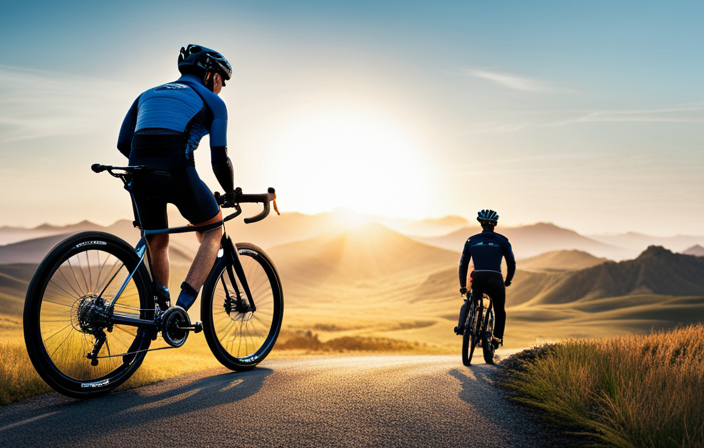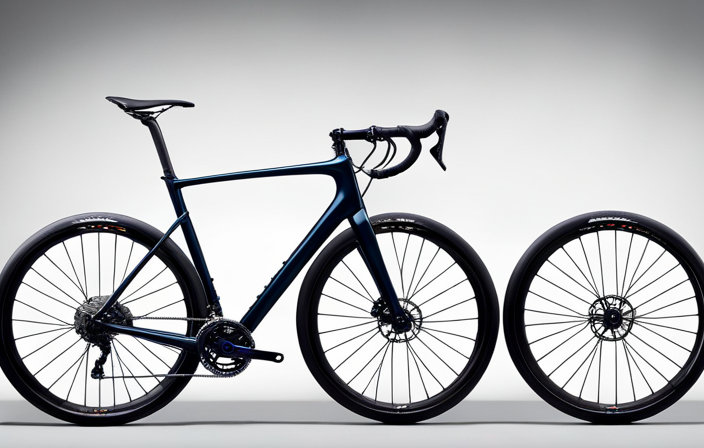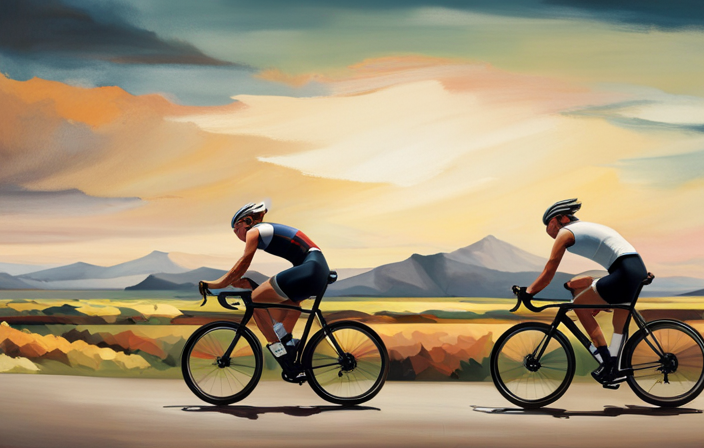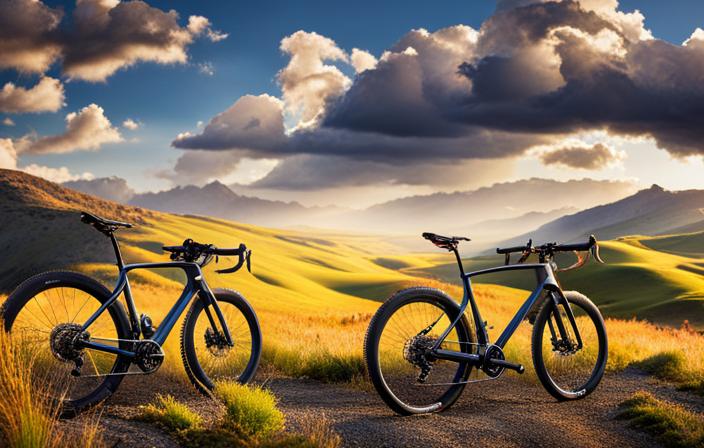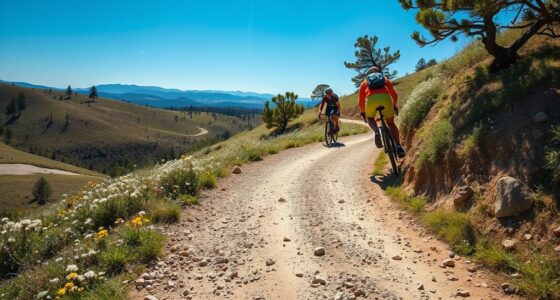Are you aware that changing gears on a gravel bike can significantly improve your cycling experience? By mastering the correct technique, you can effortlessly tackle any kind of landscape.
In this article, I will guide you through the process of shifting gears on a gravel bike, from understanding gear ratios to anticipating terrain changes.
By following these steps and maintaining your bike’s gear system, you’ll be able to navigate any trail with ease and have an enjoyable ride every time.
Key Takeaways
- Understand the gear system of your gravel bike and how it works for efficient shifting and performance.
- Anticipate terrain changes and shift preemptively to maintain momentum and smoothness.
- Regularly maintain and troubleshoot your gear system to ensure seamless shifting.
- Utilize your bike’s momentum and optimize gear selection for diverse terrains to enjoy a smooth and efficient ride.
Get Familiar with Your Bike’s Gear System
First, you’ll want to get familiar with your bike’s gear system. Understanding how your gears work is essential for efficient shifting and overall bike performance. Proper gear maintenance and troubleshooting can help prevent mechanical issues and ensure a smooth ride.
Start by examining the components of your gear system. Most gravel bikes have a combination of front and rear gears that work together to provide different speed options. The front gears, also known as chainrings, are located near the pedals, while the rear gears, called cogs or sprockets, are attached to the rear wheel hub.
To shift gears, use the shifters located on your handlebars. The right shifter controls the rear derailleur and shifts between larger and smaller cogs at the back. The left shifter operates the front derailleur, allowing you to move between chainrings.
If you encounter any issues with shifting, such as difficulty changing gears or skipping chains, it may be due to improper adjustment or worn-out components. Regular gear maintenance involves cleaning and lubricating the drivetrain, checking for loose bolts or cables, and ensuring proper alignment.
Understanding the different gear ratios will allow you to choose the appropriate combination for various terrains or riding conditions. This knowledge enables smoother transitions between gears without disrupting your pedaling rhythm.
Understand the Different Gear Ratios
To better understand the different gear ratios, you should start by familiarizing yourself with how your gravel bike’s drivetrain operates. Gear selection is crucial for maintaining efficiency and optimizing power transfer on different terrains. Here are some key points to help you understand gear ratios:
-
Front Chainring: The front chainring determines the overall gear ratio range of your bike. Larger chainrings provide higher gears for faster speeds on flat terrain, while smaller ones offer lower gears for climbing steep hills or navigating rough surfaces.
-
Rear Cassette: The rear cassette consists of multiple sprockets that work in conjunction with the front chainring. Each sprocket represents a different gear ratio to fine-tune your pedaling effort. Smaller sprockets provide easier gears, while larger ones offer harder gears.
-
Shifting Technique: Proper shifting technique is essential to smoothly transition between gears without straining the drivetrain or losing momentum. Anticipate changes in terrain and shift preemptively to maintain a steady cadence. Use lighter gears when starting from a stop or climbing uphill, and switch to heavier gears when riding on flat roads or descending.
Understanding these gear ratios will help you make informed decisions regarding when to shift up or down. By mastering the art of gear selection, you can optimize your gravel bike’s performance and ride with confidence in any situation.
Know When to Shift Up or Down
Knowing when to change to a higher or lower gear is crucial for maintaining efficiency and maximizing power transfer on different terrains. On a gravel bike, it becomes even more important as the rough surface can greatly affect your ride. Shifting gears at the right moment ensures a smooth and efficient experience.
One discussion idea related to this subtopic is the benefits of using a gear ratio calculator for gravel biking. These calculators help riders determine the most optimal gear ratios based on their fitness level, terrain, and desired speed. By inputting these factors, cyclists can find the ideal combination that allows them to pedal comfortably while still maintaining good traction and control.
Another relevant discussion point is how to properly shift gears while climbing on a gravel bike. Climbing requires careful consideration of gear selection to maintain momentum without exerting too much effort. Knowing when to shift up or down during climbs can help riders find their rhythm and conquer challenging inclines with confidence.
Understanding when to shift up or down on a gravel bike is essential for achieving a smooth and efficient ride. By utilizing tools like gear ratio calculators and mastering shifting technique while climbing, cyclists can optimize their performance on diverse terrains. Anticipating terrain changes allows for seamless transitions between sections without compromising momentum or control.
Anticipate Terrain Changes
One key aspect of a smooth and efficient ride is being able to anticipate changes in the terrain. Terrain adaptation is crucial when riding a gravel bike as it allows you to adjust your riding technique accordingly. By anticipating upcoming changes in the terrain, such as steep climbs or rough descents, you can shift gears preemptively to maintain optimal cadence and power output.
To help illustrate this concept, consider the following table:
| Terrain Type | Riding Technique | Gear Selection |
|---|---|---|
| Uphill | Seated climbing position | Lower gear |
| Downhill | Off the saddle descending | Higher gear |
| Loose gravel | Light grip on handlebars | Lower gear |
| Smooth surface | Aero tuck position | Higher gear |
Adapting your riding technique and selecting the appropriate gear for each type of terrain will enhance your overall performance and make your ride more enjoyable. Remember, it’s important to shift before you need to, ensuring a seamless transition between terrains.
Transitioning into the next section about ‘shift before you need to’, it’s essential to stay one step ahead by anticipating upcoming changes in terrain.
Shift Before You Need to
Anticipating changes in terrain allows for a smoother ride, so it’s crucial to shift gears before you actually need to. When riding a gravel bike, shifting techniques play a vital role in maintaining control and efficiency. To shift smoothly, it’s important to maintain proper gear maintenance. Regularly cleaning and lubricating your drivetrain will ensure that the shifting process is seamless. Additionally, make sure that your gears are properly indexed and adjusted for optimal performance.
When approaching an upcoming change in terrain, such as climbing a steep hill or navigating through loose gravel, it’s best to shift into an easier gear beforehand. This will allow you to maintain momentum and power through the challenging sections more effortlessly. Waiting until you’re already struggling or losing speed can result in abrupt shifts and potential chain drop-offs.
By shifting before you need to, you’ll be able to anticipate the changing conditions and adjust accordingly without losing speed or stability. This proactive approach enables a smoother transition between different terrains, making your ride more enjoyable and efficient.
Transitioning into the subsequent section about ‘use your bike’s momentum,’ understanding how to utilize your bike’s momentum is essential for maintaining speed on various surfaces without excessive pedaling effort.
Use Your Bike’s Momentum
To maintain speed and reduce pedaling effort on different surfaces, you can make use of your bike’s momentum. Using momentum effectively is crucial when shifting gears on a gravel bike. It allows for a smoother transition between gears and helps to maintain balance while shifting.
One way to utilize your bike’s momentum is by shifting gears before you reach a steep incline or decline. This ensures that you have the right gear engaged before encountering the change in terrain, allowing you to seamlessly continue riding without losing speed or balance.
Another technique is to shift gears while coasting downhill or on flat sections of the trail. By taking advantage of the bike’s natural forward motion, you can shift smoothly without putting excessive strain on the drivetrain. This not only reduces pedaling effort but also minimizes the risk of chain slippage or other mechanical issues.
To help illustrate these techniques visually, here is a table showcasing some common scenarios where using your bike’s momentum effectively can be beneficial:
| Scenario | Action |
|---|---|
| Approaching steep uphill | Shift into an easier gear beforehand |
| Descending a hill | Shift into a harder gear while coasting |
| Riding on uneven terrain | Shift into a lower gear to maintain balance |
By mastering these techniques, you can enhance your riding experience on gravel roads and trails. Now, let’s explore how finding the right cadence plays a vital role in optimizing your performance and efficiency on a gravel bike.
Find the Right Cadence
Make sure you find the right cadence to optimize your performance and efficiency on your ride. Here are three key tips to help you achieve this:
-
Find the right gear: It’s crucial to select the appropriate gear for the terrain and conditions you’re riding in. When pedaling uphill, choose a lower gear to maintain a steady cadence without straining your muscles. On flat or downhill sections, shift into a higher gear to increase speed without overexerting yourself. Experiment with different gears until you find the one that allows you to pedal smoothly and comfortably.
-
Pedal efficiently: To maintain an optimal cadence, focus on applying power throughout each pedal stroke. Push down with your legs while engaging your core muscles, then pull up as you complete the rotation. This balanced effort ensures that every ounce of energy is utilized effectively, preventing unnecessary fatigue.
-
Listen to your body: Pay attention to how your legs feel during different cadences and adjust accordingly. If it feels like you’re spinning too quickly without enough resistance, shift into a harder gear. Conversely, if it feels like you’re pushing too hard and struggling to maintain rhythm, shift into an easier gear.
By finding the right cadence and maximizing pedal efficiency, you can enhance your overall riding experience and avoid cross-chaining which we will discuss in the next section about ‘avoid cross-chaining’.
Avoid Cross-Chaining
To avoid cross-chaining, ensure you maintain a proper alignment of your chain and gears while riding. Cross-chaining occurs when you use extreme gear combinations that cause the chain to run at an angle. This can put unnecessary stress on both the chain and the drivetrain components, leading to increased wear and potential damage.
Improving your gear shifting technique is key to avoiding cross-chaining. When shifting gears, try to anticipate changes in terrain or cadence and shift proactively rather than waiting until you’re already in a difficult gear combination. Pay attention to the position of your chain on both the front and rear gears. Ideally, you want the chain to be as straight as possible from one gear to another.
When shifting up or down, make sure you ease off the pedal pressure slightly to allow for smooth transitioning between gears. Additionally, avoid shifting under heavy load or while standing on the pedals as this can also increase the risk of cross-chaining.
By practicing these techniques and being mindful of your gear selection, you can improve your overall cycling experience and prolong the lifespan of your drivetrain components.
In the next section, we’ll explore how to practice shifting on different surfaces without compromising your performance.
Practice Shifting on Different Surfaces
Practicing shifting on various surfaces can help improve your cycling skills and enhance your overall performance. When it comes to riding a gravel bike, being able to shift gears smoothly and efficiently is crucial, especially when encountering uneven surfaces. Mastering gear changes on loose gravel requires practice and familiarity with how your bike responds to different terrain.
Shifting on uneven surfaces can be challenging due to the lack of traction. It’s important to anticipate the terrain ahead and shift into an appropriate gear before you reach it. This will prevent any sudden jolts or loss of control as you navigate through the gravel.
To practice shifting on different surfaces, find various terrains such as grassy fields, dirt trails, or even cobblestone streets. Start by riding at a moderate pace and experiment with shifting up and down gears while maintaining a smooth pedal stroke. Pay attention to how your bike reacts to each gear change and make adjustments accordingly.
By practicing shifting on different surfaces, you’ll develop a better understanding of how your bike handles under different conditions. This will allow you to confidently navigate through gravel roads without sacrificing speed or control.
Transitioning into the next section about learning how to feather the gears, it’s essential to understand that mastering gear changes is just one aspect of becoming proficient in shifting techniques.
Learn How to Feather the Gears
When it comes to shifting gears on a gravel bike, one crucial technique to master is feathering the gears. This skill allows for smooth and efficient transitions between gears, ensuring optimal power transfer and control on varying terrains.
Feathering the gears refers to lightly touching the shifters to make small adjustments in gear ratios. By doing so, you can fine-tune your cadence and maintain a consistent pedaling rhythm without any jarring shifts that could compromise traction on loose surfaces like gravel.
To better understand the benefits of feathering the gears, let’s take a look at this table:
| Feather Technique Benefits | Common Mistakes in Feathering Gears |
|---|---|
| Smooth gear transitions | Applying too much force when shifting |
| Maintaining traction on gravel | Shifting during high torque moments |
| Consistent pedaling efficiency | Neglecting proper chain alignment |
By practicing the feather technique correctly, you’ll experience improved control over your bike while navigating different surfaces. However, it’s essential to avoid common mistakes such as applying excessive force or shifting at high torque moments.
Now that we’ve covered feathering the gears, let’s move on to experimenting with different shifting techniques to further enhance your gravel biking skills.
Experiment with Different Shifting Techniques
Try out various techniques for changing your speed and gear ratios to enhance your performance on different terrains. When riding a gravel bike, it’s essential to experiment with gear combinations and try different shifting techniques. This allows you to find the most efficient way to navigate through various conditions.
One technique you can try is called ‘double shifting.’ This involves quickly shifting two gears at once, which can help you maintain momentum when transitioning between different surfaces.
Another technique is ‘pre-shifting,’ where you anticipate the need for a gear change before actually needing it. By shifting ahead of time, you can smoothly transition into the new gear without any interruption in your pedaling cadence.
Additionally, experimenting with how you shift can make a difference in your overall performance. Some riders prefer to shift gears one at a time, while others may find success with multiple shifts in quick succession. It’s important to pay attention to how these techniques affect your bike’s response and adjust accordingly.
By trying out different shifting techniques and observing how they impact your ride, you can optimize your gravel biking experience. Listening to your bike will provide valuable feedback on what works best for you.
Listen to Your Bike
One way to optimize your performance is by paying attention to the feedback your bicycle provides. When riding a gravel bike, it’s crucial to listen to your bike in order to effectively shift gears. Feeling the road beneath you can give valuable information about when and how to shift.
On rough terrain, you may need to anticipate upcoming obstacles and downshift beforehand for better control. Understanding bike signals, such as chain noise or resistance, can also help determine when it’s time to shift gears. For example, if you feel excessive resistance while pedaling uphill, shifting into a lower gear can make climbing easier and prevent strain on your legs. Similarly, if you hear the chain rattling or skipping under load, shifting into a higher gear can alleviate this issue.
By listening attentively and understanding these signals from your bike, you can enhance your overall riding experience on a gravel bike. This will ensure that you are always in the right gear for optimal efficiency and power transfer.
Now let’s explore how maintaining your bike’s gear system plays an essential role in maximizing its performance without compromising safety.
Maintain Your Bike’s Gear System
After listening to my bike and ensuring it’s in good working order, the next step in shifting gears on a gravel bike is to maintain the gear system. Proper bike maintenance is crucial for smooth and efficient gear shifting. One of the most important aspects of gear maintenance is regular gear adjustment.
To maintain your bike’s gear system, follow these steps:
-
Check for any loose or damaged cables: Inspect the cables that connect the shifters to the derailleurs, ensuring they are secure and without frays or kinks.
-
Lubricate moving parts: Apply lubricant to key components such as the derailleur pulleys and chain, keeping them clean and running smoothly.
-
Fine-tune derailleur alignment: Use barrel adjusters to make precise adjustments to ensure accurate shifting between gears.
-
Monitor chain wear: Regularly inspect your chain for signs of wear and replace it if necessary, as a worn-out chain can impact gear performance.
By following these maintenance practices, you can optimize your bike’s gear system for seamless shifting on various terrains.
Now that we have covered how to maintain your bike’s gear system, let’s move on to the next section about getting a professional bike fit…
Get Professional Bike Fit
To ensure optimal comfort and efficiency while riding, it is recommended to get a professional bike fit. A proper bike fit is of utmost importance, as it can greatly enhance your cycling experience and prevent potential injuries.
During the bike fit process, a trained professional will analyze your body’s biomechanics and make necessary adjustments to your bike’s components such as saddle height, handlebar position, and cleat alignment. These adjustments are tailored specifically to your unique body measurements and riding style.
Getting a professional bike fit not only ensures that you are in the correct riding position but also maximizes power transfer, minimizes strain on joints, and reduces the likelihood of developing discomfort or pain during long rides. It allows for efficient pedaling motion by optimizing the alignment of your hips, knees, and ankles.
With a properly fitted bike, you will experience improved stability, control, and overall performance. So don’t underestimate the importance of investing in a professional bike fit before hitting the trails or roads.
Now that you have achieved an ideal bike fit, it’s time to keep practicing and having fun!
Keep Practicing and Have Fun!
Keep practicing and having fun on your newly fitted bike to fully enjoy the cycling experience. Improving your shifting techniques is crucial to optimizing your performance on a gravel bike. Here are some benefits of practicing on gravel trails:
-
Enhanced balance: Riding on uneven terrain like gravel trails helps improve your balance and stability, which are essential for efficient gear shifting.
-
Increased confidence: By repeatedly shifting gears on different types of surfaces, you’ll gain confidence in your ability to handle various terrains.
-
Improved timing: Practicing gear shifts on gravel trails allows you to become more familiar with the timing required for smooth transitions between gears.
-
Better control: The unpredictable nature of gravel trails requires constant adjustments in gear selection, allowing you to develop better control over your bike.
-
Enhanced muscle memory: Regular practice fosters muscle memory, making gear changes more instinctive and effortless.
Remember, the key is to keep practicing regularly and gradually increase the difficulty level as you progress. Enjoying the process will make it easier to stay motivated and committed.
So get out there, explore those gravel trails, and have fun while fine-tuning your shifting techniques!
Frequently Asked Questions
How often should I maintain my bike’s gear system?
I should maintain my bike’s gear system regularly to ensure optimal performance. Proper bicycle gear maintenance is essential for smooth shifting and avoiding potential issues.
Regular cleaning and lubrication of the drivetrain components, such as the chain, cassette, and derailleur, will help prevent wear and tear.
Additionally, periodic gear system troubleshooting can identify any problems early on and allow for timely repairs or adjustments to be made.
What are some signs that my bike’s gear system may need maintenance?
Common gear problems can arise in a bike’s gear system, indicating the need for maintenance. Some signs to watch out for include difficulty shifting gears smoothly, gears slipping or skipping under load, and excessive noise or grinding sounds.
Troubleshooting gear issues involves checking the cable tension, limit screws, and derailleur alignment.
Regular maintenance is essential to prevent these problems and ensure optimal performance of your bike’s gear system.
Can I shift gears while I am riding uphill?
Shifting gears while riding uphill can be tricky, but with the right technique and gear selection, it’s definitely possible.
By smoothly shifting to a lower gear before tackling the incline, you’ll maintain momentum and avoid straining your legs.
Remember to anticipate the terrain and adjust your gears accordingly.
It’s all about finding that balance between power and cadence.
So don’t hesitate to shift gears when needed, even when climbing uphill!
What should I do if my gears are not shifting smoothly?
If my gears are not shifting smoothly, there are some troubleshooting tips I can try.
Common gear shifting issues include a misaligned derailleur, cable tension problems, or a worn-out chain.
To fix these issues, I would start by checking if the derailleur hanger is straight and the cables are properly tensioned. If necessary, I would adjust the limit screws on the derailleur or replace the chain.
Regular maintenance and keeping my drivetrain clean can also prevent future shifting problems.
How do I know if I need to replace my bike’s gear system?
If my bike’s gear system is showing signs of wear, such as skipping gears or difficulty shifting, it may be time for a replacement.
One telltale sign is excessive chain slippage or noise while pedaling.
Another indicator is worn-out teeth on the cassette or chainrings.
Additionally, if the derailleur is unable to properly align with the gears, it may be time for a new gear system.
Regular maintenance and inspection can help identify these issues early on.
Conclusion
So there you have it, shifting gears on a gravel bike doesn’t have to be complicated. By following these simple steps and practicing regularly, you’ll become more confident in your gear shifting skills.
One objection you might have is that it takes time and effort to learn how to shift gears properly. While it’s true that mastering gear shifting does require practice, the benefits of smooth and efficient riding far outweigh the initial learning curve.
So don’t be discouraged, keep at it, and soon enough you’ll be smoothly navigating any terrain on your gravel bike with ease!
